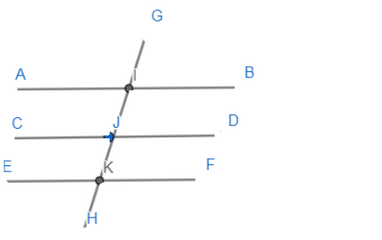What is transversal?
The transversal is a straight line that passes across any set of straight lines(at least two) in the same plane, intersecting each line at one distinct point.While doing so, it forms various angles between the lines as shown.It forms corresponding angles, vertical angles, adjacent angles and alternate angles.

In the above figure, AB and CD are any two lines in a plane and EF is a transversal.
It cuts the lines forming 8 angles.
Angles lying side by side are adjacent angles.They are not necessarily equal.
1 and 2 ,1 and 4, 2 and 3, 3 and 4 are all adjacent angles.
Angles lying vertically opposite are vertical angles.They are always equal.
1 and 3, 2 and 4, 5 and 7, and 6 and 8 are vertical angles.
1 and 5, 4 and 8, 2 and 6, 3 and 7 are corresponding angles.
1 and 7, 2 and 8 are alternate exterior angles.
4 and 6, 3 and 5 are alternate interior angles.
Only, when the lines AB and CD are parallel, each pair of corresponding angles ,alternate interior angles, alternate exterior angles, become equal.
Note that interior angles on the same side of the transversal, become supplementary. i.e. sum is 180. i.e angles 4 and 5, and 3 and 6.
The converse is also true that whenever corresponding or alternate angles are equal, or when the sum of interior angles on the same side of the transversal is 180, then the lines are parallel.




